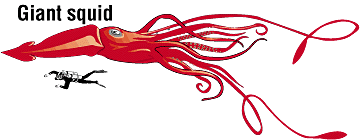Published in the Ocean Watch column, Honolulu Star-Advertiser © Susan Scott
February 10, 1997
IT’S amazing to me that enormous squid, 50 or 60 feet long, live here in the Pacific ocean, perhaps in our back yard, yet no one has seen one alive.
Now some light may be shed on these obscure animals. A group of researchers is traveling to the South Pacific to try to film giant squid in their home territory. The scientists will lower remote-controlled cameras, baited with squid food, to as deep as 10,000 feet.

If the effort is successful, the team will have cracked one of the biggest marine biology mysteries of all time: Where and how do giant squid live?
Myths and stories about these elusive deep-water creatures have been with us for centuries. Norwegian sailors called these big invertebrates kraken and others knew them as polyps (Greek for many-footed). But for most people, giant squid are simply sea monsters.
The image of a slimy skinned, 50-foot-long creature waving around 10 sucker-lined appendages does give me a little shiver. But the truth is, in spite of the stories of these “sea serpents” wrecking boats and grabbing people for lunch, no such attacks have been confirmed.
Besides that, it just doesn’t make sense that giant squid would be interested in eating humans. These animals live in the dark, cold depths of the ocean and healthy specimens never rise.
What do giant squid eat? Probably anything they can get their appendages around, most likely fish and other squid.
Squid appendages are unique. Most species, large and small, have 10. Eight of these appendages, called arms, are short and heavy, like those of their close relatives, octopuses. Like octopuses, cup-shaped suckers cover the inner flat surface of each arm in most species.
But the rims of squid suckers contain toothlike material and sometimes the inner walls bear hard hooks. These hooks, teeth and suckers help the creatures hold onto their slippery prey.
It is the hard parts of the giant squid’s suckers that leave scars on the skin of their main predators, the sperm whales.
Besides eight arms, most squid have two other appendages, called tentacles. Only the spatula-shaped tips of these long tentacles contain suction cups.
Squid tentacles are the business end of the animal, shooting out with tremendous speed to seize passing prey. The tentacles retract, drawing the food to the arms which hold it up to the creature’s mouth. There the squid tears the prey apart with strong jaws.
Capturing food in dark, sparsely populated ocean depths is difficult at best. But squids have superb eyesight. Also, they can instantly change color, have the ability to shoot out clouds of dark “ink,” and some species glow in the dark. All these strategies confuse prey.
They also fascinate people.
When I lean over the side of a boat at sea, I often wonder: What’s down there really, really deep?
Hopefully, we’ll soon find out.